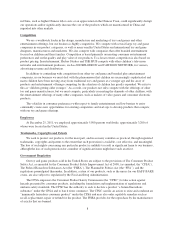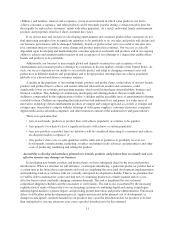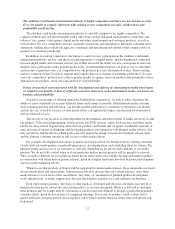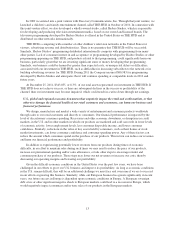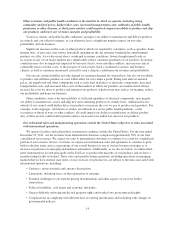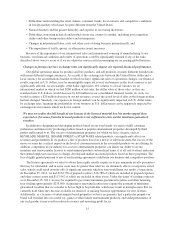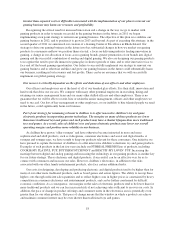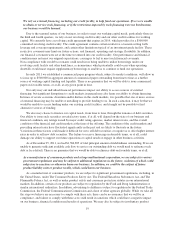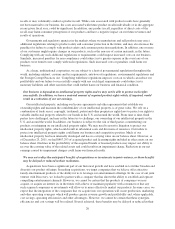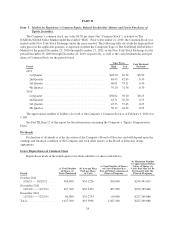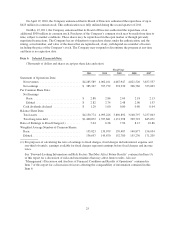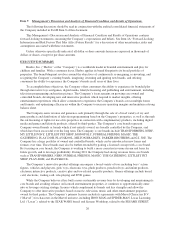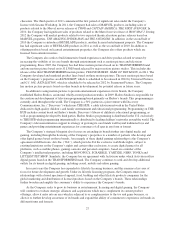Hasbro 2011 Annual Report Download - page 27
Download and view the complete annual report
Please find page 27 of the 2011 Hasbro annual report below. You can navigate through the pages in the report by either clicking on the pages listed below, or by using the keyword search tool below to find specific information within the annual report.Greater than expected costs or difficulties associated with the implementation of our plan to reinvent our
gaming business may harm our revenues and profitability.
Recognizing the critical need for increased innovation and a change in the way we go to market with
gaming products in order to remain successful in the gaming business in the future, in 2011 we began
implementing a ten point strategy to reinvent our gaming business. The objective of this plan is to stabilize our
gaming business in 2012, and to position it to grow in 2013 and beyond. As part of executing this strategy, in the
second quarter of 2011 we announced our creation of a Gaming Center of Excellence in Rhode Island. Our
strategy to drive our gaming business in the future involves substantial changes in how we market our gaming
products to consumers and how we position them at retail, a focus on delivering industry leading innovation in
gaming, a change in our allocation of focus across gaming brands, greater penetration of our brands into digital
gaming and the successful combination of analog and digital gaming. We also are designing our gaming products
to recognize the need to provide immersive game-play in shorter periods of time, and to offer innovative face to
face and off the board gaming opportunities. Our failure to successfully implement our strategy to reinvent our
gaming business and to otherwise stabilize and grow our gaming business in the future could substantially harm
our business, resulting in lost revenues and lost profits. There can be no assurance that we will successfully
implement our global gaming strategy.
Our success is critically dependent on the efforts and dedication of our officers and other employees.
Our officers and employees are at the heart of all of our branded play efforts. It is their skill, innovation and
hard work that drive our success. We compete with many other potential employers in recruiting, hiring and
retaining our senior management team and our many other skilled officers and other employees. There is no
guarantee that we will be able to recruit, hire or retain the senior management, officers and other employees we
need to succeed. Our loss of key management or other employees, or our inability to hire talented people we need
in the future, could significantly harm our business.
Part of our strategy for remaining relevant to children is to offer innovative children’s toy and game
electronic products incorporating greater technology. The margins on many of these products are lower
than more traditional toys and games and such products may have a shorter lifespan than more traditional
toys and games. As a result, sales of children’s toy and game electronic products may lower our overall
operating margins and produce more volatility in our business.
As children have grown “older younger” and have otherwise become interested in more and more
sophisticated and adult products, such as videogames, consumer electronics and social and digital media, at
younger and younger ages, we have sought to keep our products relevant for these consumers. One initiative we
have pursued to capture the interest of children is to offer innovative children’s electronic toy and game products.
Examples of such products in the last few years include our FURREAL FRIENDS line of products, including
COOKIE-MY PLAYFUL PUP, BUTTERSCOTCH PONY and BISCUIT-MY LOVIN’ PUP. Increasing the
marriage between digital and analog gaming and increasing the technology in our gaming products is another key
for our future strategy. These electronic and digital products, if successful, can be an effective way for us to
connect with consumers and increase our sales. However, children’s electronics, in addition to the risks
associated with our other family entertainment products, also face certain additional risks.
Our costs for designing, developing and producing electronic and digital products tend to be higher than for
many of our other more traditional products, such as board games and action figures. The ability to recoup these
higher costs through sufficient sales quantities and to reflect higher costs in higher prices is constrained by heavy
competition in consumer electronics and entertainment products, and can be further constrained by difficult
economic conditions. As a consequence, our margins on the sales of electronic products tend to be lower than for
more traditional products and we can face increased risk of not achieving sales sufficient to recover our costs. In
addition, the pace of change in product offerings and consumer tastes in the electronics area is potentially even
greater than for our other products. This pace of change means that the window in which a product can achieve
and maintain consumer interest may be even shorter than traditional toys and games.
18


